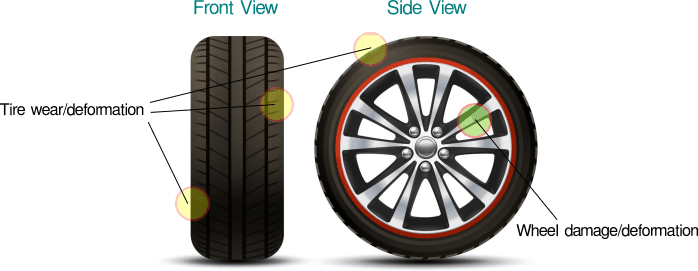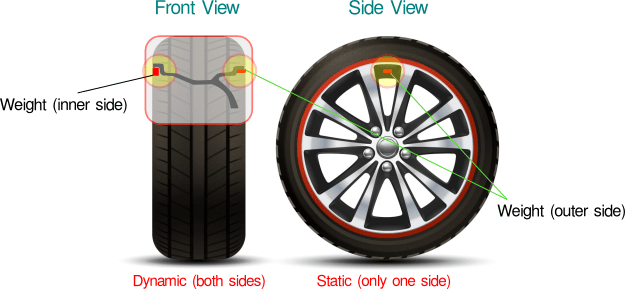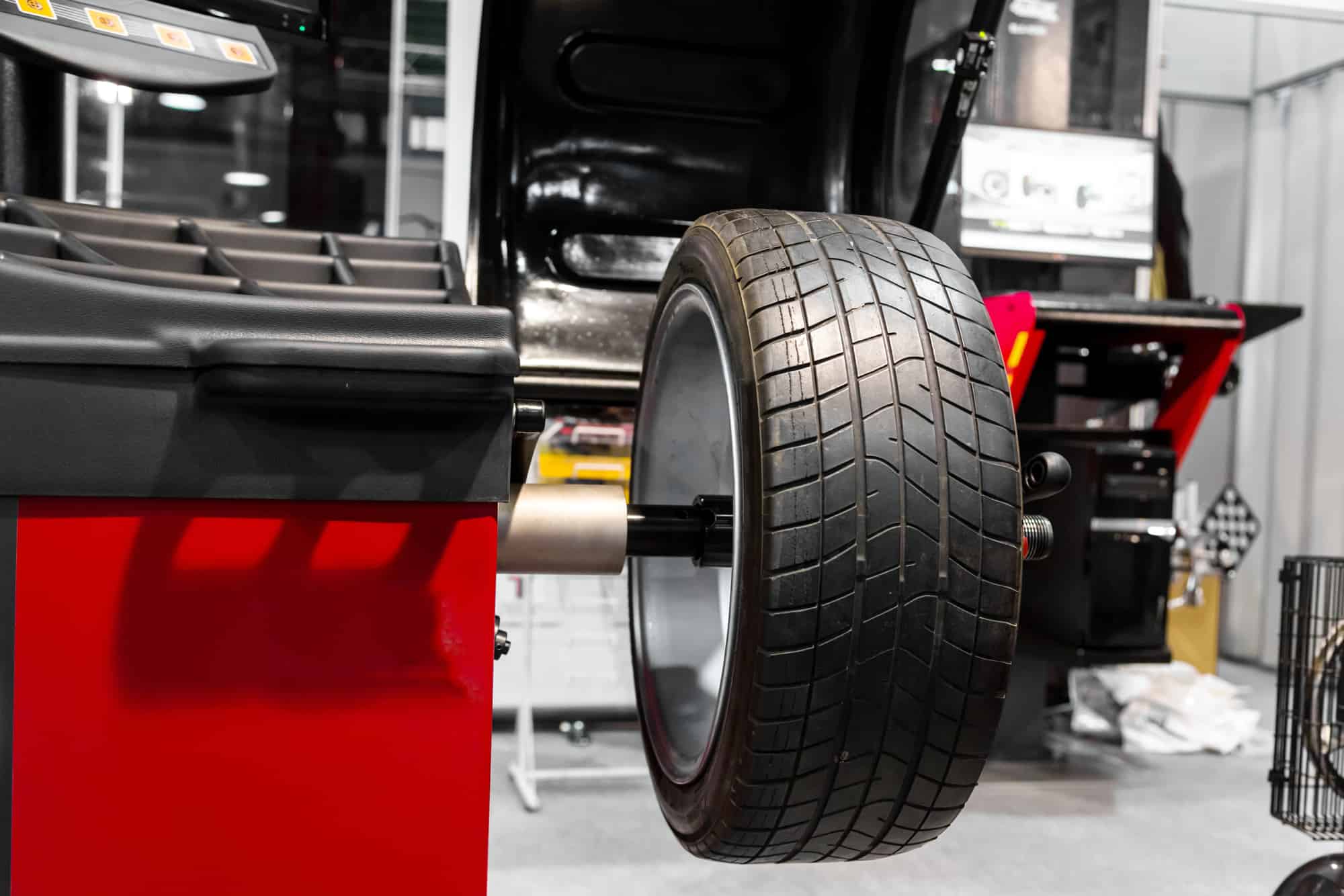Wheel balancing and wheel alignment are two very important wheel related procedures that are often confused with one another.
Wheel balancing involves the addition of small weights to the wheel to ‘balance’ out any small imperfections in the wheel shape.
Wheel alignment is the adjustment of specific suspension parts that align the wheel to the vehicle horizontally and vertically.
As an Amazon Associate we earn from qualifying purchases.
What Is The Difference Between Wheel Alignment Vs Wheel Balancing?
Wheel balancing is probably the most underrated service in the automotive industry. You’ll find endless debates online among car owners and enthusiasts as to the symptoms and causes of unbalanced tires or misaligned wheels.
A lot of the confusion and debate revolves around the misconception that wheel balancing and wheel alignment are the same thing.
Wheel alignment involves changing the angle of the wheels in relation to each other and the road, by adjusting certain suspension components. Misaligned wheels can cause lots of different problems from bad handling to premature the premature wear or tires and suspension parts.
It’s advisable to check wheel alignment at least once a year (or sooner if you have an issue).Wheel balancing is related to tire wear and/or wheel deformation. Balancing a wheel basically involves fixing one or more small weights to a wheel to ‘balance’ out any imperfections that occur as the wheel rotates.
Symptoms of A Wheel that Needs To Be Balanced?
A wheel that needs balancing will usually cause a vibration when you are driving, especially at higher speeds.
Getting the wheels checked on a balancing machine is often a cheap and easy way to fix vibrations, especially vibrations that can be felt through the steering wheel. Of course, the vibrations could be caused by many other things, some of which I’ve written about in my article on shaking steering wheels.
If the tire or wheel is to blame, then where do these vibrations come from?

Ideally, a tire should have a perfect cylindrical shape. Reality is, that even new tires have imperfections.
Tire makers invest billion of dollars enhancing the manufacturing process, but even so, small imperfections are always present.
Wheels are not perfect either, even new wheels.
No matter if they are cast iron, titanium alloy, you name it, wheels can also have small imperfections.
More expensive brands manage to lower those imperfections to an acceptable minimum known as the accepted “tolerance”. The problem is, these small flaws still cause vibrations, even when they are within the accepted tolerance, and lowering these tolerances is not usually an option on standard road cars because it’s just too expensive.
So the solution is to balance the wheel by adding small weights that counteract the imperfections.
Do You Always Need To Get Your Wheels Balanced?
Wheel balancing is still the cheapest and most effective solution when it comes to dealing with imperfections in wheels and tires.
Unfortunately the problem doesn’t end with the manufacturing process. There is another factor not mentioned yet: tire wear.
Tires wear is inevitable.Most tires will wear unevenly no matter how new the suspension is even how well aligned the wheels are.
This is because the friction between the tires and the road is not distributed equally.
And then there’s the wheels themselves. They obviously don’t wear like tires do but they may suffer occasional damage and deformation from bumpy roads, potholes or even while parking if you accidentally hit the sidewalk.
So it’s important as your car or truck ages to get the wheels balanced regularly as they wear. This will help to reduce premature suspension wear and will generally improve the ride.
How Does Wheel Balancing Work?
The main goal of balancing the wheels of a car, is to counteract the vibration produced by their inherent unbalance.
This is accomplished by attaching weights (also called counterweights) to the wheels at specific points so that they help to equilibrate the tire/wheel assembly.
How much weight and where to locate it is very important when it comes to accurately balancing a wheel.
The weight of the counterweight should be as close to as necessary to cancel the vibration, and can’t be more or less.
This should then be positioned at the exact opposite point of the unbalancing weight. In technical terms, when talking about “counterweight location” we are talking about a location in a three dimensional space.
As you may imagine, balancing a wheel isn’t something you can just do by looking at it, and you won’t be able to do it yourself at home.
Instead you will need the use of a specialised machine called a “wheel balancer”.
The wheel balancer makes wheel balancing a much simpler job. The wheel with tire is mounted onto the machine and is rotated at fairly high speeds to mimic how the wheel performs on the road.
The wheel balancer measures any imperfections and indicates where you should attach the counterweight and also how many grams (or ounces) it should have.
Common Questions About Wheel Balancing
Wheel balancing can be a complex topic. There are lots of myths and misinformation out there in relation to it, especially when it comes to wheel balancing vs wheel alignment.
Why Is Wheel Balancing Necessary?
There is no way to attach a counterweight to a tire (unless you bond a patch to it) so you cannot “balance” a tire. New tires can be balanced once they are fitted to the corresponding wheel because you can attach weights to it. Believe it or not, many tires are returned to factory due to flaws that can’t be fixed with a wheel balancer (need an excessive counterweight).
That said, tires do come from the factory with a reference (usually a small circular sticker) that points its heaviest spot. Ideally, wheels also have a visual reference of its heaviest spot. A good technician always tries to assemble the wheel in a way that both references end up in opposing sides (180° from each other). If both references are located too close the amount of counterweight required can be so high that could mislead the issue as a “bad tire”.
What are the Two types of wheel balancing?
Without diving into theory, let’s simplify the discussion saying that the static mode of a wheel balancer sees the tire as a bidimensional shape, like a disc. Results won’t be accurate. You can balance the wheel but it won’t perform optimally at high speeds. Also, you most probably will end up using too many weights affecting wheel aesthetics considerably. On the other hand, the dynamic mode sees the wheel as a tridimensional shape, like a cylinder and thus its accuracy is far better than the static mode.
You may ask if that’s true, why the wheel balancer has a static mode? And why some technicians insist that both modes do the same?
The reason behind keeping a static mode is convenience. When you use the wheel balancer in the static mode you attach all counterweights on the same side of the wheel, usually the outer side. Sometimes, even when not totally accurate, using the static mode is the right choice. For example, imagine a off-road vehicle with mud tires. Remember about tire wear? Mud tires are a nightmare in that sense. They are not designed for highway use, so there is no point in looking for accuracy at high speeds. The static mode allows balancing that kind of wheels very easy. Aesthetics, and performance at high speeds are not important for that kind of applications.

The dynamic balancing mode is another story altogether. For starters, there is more than one dynamic mode, in fact, there are many. The dynamic mode allows weight placement on both sides of the wheel (inner and outer sides). That is important not only from a performance point of view but also aesthetics. A thousand dollar wheel should not be showing counterweights. Different dynamic modes bring the flexibility to locate the weights in different positions. The downside of the dynamic balancing mode is time. The technician will need more time to find the optimal setup for your wheel. And time is money.
What Happens If Your Wheels Aren’t Balanced Or Aligned?
If the wheels on your car are not balanced or aligned properly, then it will affect the handling, the ride and the condition of the suspension over time.
1. Excessive tire wear
Unbalanced wheels will cause uneven tire wear. This is caused by the wheel not running on the road evenly. This will cause the tires to wear more on the inside or outside and this will eventually cause handling issues.
2. Handling instability
Wheels that are not balanced and aligned will seriously degrade the handling and performance of a vehicle. If everything doesn’t line up with the suspension as designed, the car will obviously not handle as well as it should, especially at faster speeds.
3. Excessive stress on shock absorbers
Shock absorbers are constantly adjusting to the imperfections on the road surface. A misaligned wheel will put extra pressure on the shock absorber, causing it to wear prematurely. This is caused by the wheel not contacting the road surface at the correct angle.
4. Excessive stress on wheel bearings
When you are driving, the wheel bearings are constantly turning. Any extra vibrations or knocking caused by misaligned wheels will put extra pressure on the wheel bearings.
5. Excessive stress on other suspension components
Just like the shocks and wheel bearings, every other suspension part is interlinked and can be affected by additional vibrations and pressure from misaligned and unbalanced wheels. The extra torque coupled with constant vibrating can wear out the rubber bushings on suspension parts very quickly.
As an Amazon Associate we earn from qualifying purchases.































I’ve been noticing some uneven wear on my tires recently and a bit of vibration when I drive at higher speeds. Could this be because of unbalanced wheels, and if so, should I get both wheel balancing and alignment checked to resolve this issue?
I’ve recently started noticing a vibration in my steering wheel, especially when I’m driving at highway speeds. Could this be an indication that my wheels need balancing or is it more likely related to some other issue? What should I specifically look for to determine the cause of this vibration?